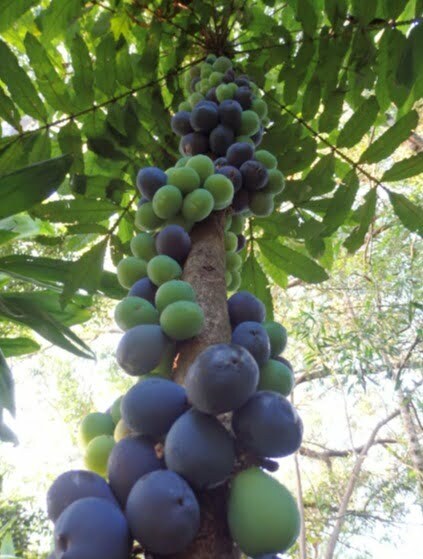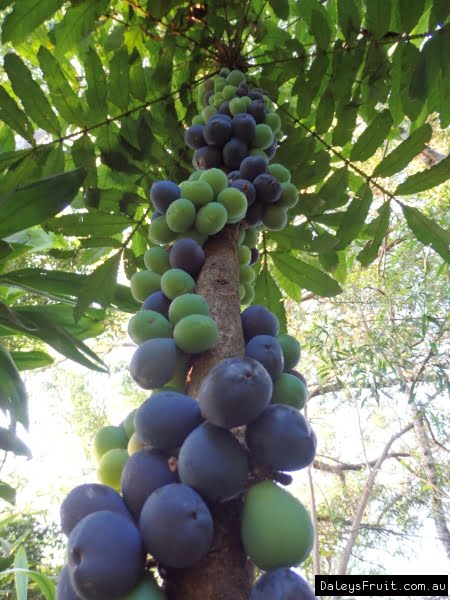
Davidsonia Jerseyana
Common name: Native plum
I grow best: Part Shade & Rainforest
• small tree growing 6-10m
• Fruiting November – February, Flowering July- January
• Any soil with rich organic matter and adequate moisture
• Cultural uses
Looks like: D. jerseyana is a slender small tree growing 6 -10m in altitudes between 100-300 m. Clusters of natural populations are mainly growing in sheltered positions on south and east facing slopes mainly in riparian and rainforest areas. Some species show few branches with several stems from the base, each with a terminal tuft of leaves. Leaves are alternate between 35-75 cm long. Each leaf has 11-17 oblong shaped leaflets, 6-30 cm long and between 3-10 cm wide. Flowers are small dark pink to red arranged on panicles, which are borne on the main stem. Fruits are dark purple in colour, oval shaped and covered with fine hairs. Fruits contain two large seed cases with a single seed and appear fibous. The fruit flesh is dark red when fully ripe.
Habitat & Distribution: NSW Davidson plum is available fresh in summer, QLD Davidson plum ripens in winter, frozen fruits or fruit puree is available all year. All Davidson’s plums can be grown in a range of soil types, however rich organic matter and adequate moisture is essential for optimum growth. D. jerseyana grows naturally in red and yellow soils showing poor soil structure, with Silurian greywacke, slate, phyllite and quartzite in the subsoil but will grow in various soil types with high organic matter and high rainfall.
Cultivation: D. jerseyana trees are planted 1-2.5 m apart in rows 2-4 m apart or in a poly-cultural setting. Young trees are prone to leaf burn in hot dry weather and may need protection in exposed sites. Competition from weeds is to be discouraged. Removal of apical shoots on young trees supports multiple stems, which may increase fruit yield. Irrigation and mulching is recommended to retain surface moisture critical in during the flowering period in spring and fruiting in summer.
Davidsonia jerseyana is endemic to the Northern Rivers region of NSW and grows naturally from the Tweed to the Brunswick River catchment. A total of 118 locations were found of endemic populations, which can be grouped into 24 naturally occurring subpopulations. In NSW all wild Davidson’s Plum are listed as Endangered on both the NSW Threatened Species Conservation Act 1995 (TSC Act) and the Commonwealth Environment Protection and Biodiversity Conservation Act 1999 (EPBC Act). Harvesting fruit from endemic populations requires a permit from NSW National Parks and Wildlife Service.
Flowering periods for D. jerseyana vary between populations and can occur from July to January. Trees often produce a second set of flowers and buds when the first flowering has poor fruit setting. Little confirmed information is available on pollination. Isolated single trees produce large quantities of fruits with viable seed, which may suggest that the trees are self-pollinating.
Fruiting of D. jerseyana in nothern NSW can occur between November to February. The majority of fresh seeds germinate quickly (50-8O%) and seedlings establish fast in good conditions growing up to 4m in 6-8 years, producing fruit within 3-4 years. Young seedlings are frost sensitve and prone to sunburn.
| Family | Cunoniaceae |
| Plant Type | Small tree, Large shrub |
| Width | 3 |
| Flowering Time | Spring |
| Soil Type | Clay, Loamy, Sandy loam, Clay loam |
| Climate Zone | Sub-tropical, Warm temperate, Cool temperate, Mediterranean |
| Growth Habit | Evergreen, Column-shaped |
| Soil Moisture | Well-drained, Moist moderate drainage |
| Special Uses | Edible, Street tree, Decorative fruit, Playground friendly |
| Height | 5 |
| Flower Colour | Cream |
| pH Level | Acid, Neutral |
| Plant Environment | Low maintenance garden |
| Light | Sunny, Light shade, Half shade |
| Lifespan | Perennial |
| Frost Tolerance | Tolerates light frost |
| Attracts Wildlife | Seed eating birds, Other insects |
Distribution:

Traditional uses: Fruits are large and purple, looks like a plums. Fruiting between November to February, with individual trees capable of producing many kilos of plums. Their refreshing tartness works well in both sweet and savoury product, such as jams, jellies, cordials, wines and meat sauces.

